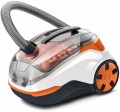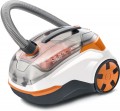Motor power
Rated power consumed by the vacuum cleaner. In models with power adjustment (see below), the maximum value is taken into account in this case. We are talking about the characteristics of the installed motor, which is the main, and in most vacuum cleaners, the only consumer of energy.
Higher power increases suction force and improves overall cleaning efficiency. In addition, a more powerful unit is easier to equip with a capacious dust collector. On the other hand, only vacuum cleaners of the same type with the same types of dust collectors can be directly compared by this parameter (see above for both). And even in such cases, the actual suction force (see below) may be different — and it is it that determines the real efficiency. However, the total power also allows you to generally evaluate the capabilities of the vacuum cleaner, including in comparison: a 1500 W model will significantly outperform its 800 W counterpart in efficiency (although it is impossible to say exactly by how much). But what definitely depends on this indicator is energy consumption.
As for specific power values, they are largely related to the type of device. For example, handheld models, robots and uproght units have low power —
less than 1500 W(and often noticeably less). Such values are quite popular among other types of vacuum cleaners (conventional, industrial, workshop, etc.), but among them there are already more solid indicators —
...f="/list/90/pr-1067/">1500 – 1750 W,
1750 – 2000 W and even
more than 2000 W.Dust collector capacity
The nominal volume of the dust collector installed in the vacuum cleaner.
This indicator largely depends on the type of unit (see above). For example, in most handheld household models, the capacity
does not exceed 0.5 L. The volume of the container in upright vacuum cleaners and robots can be somewhat larger — among the first variety there are quite a few models for
1 – 2 liters or even more, and among the second — by
0.6 – 1 liter and a little more. For conventional vacuum cleaners, the minimum figure is actually about 0.8 – 1 L; dust collectors for 1 – 2 L and
2 – 4 L are very popular in such devices; the maximum capacity is actually
4 – 6 liters — units of a similar layout, but with a larger capacity, are usually referred to as household ones. In turn, relatively small containers are occasionally found among workshop models. However, in vacuum cleaners of this type, the capacity is generally quite large — it can reach
26 – 50 liters or even
more ; the same applies to industrial (construction) units.
In general, a larger dust container allows you to work longer without interruptions. On the other hand, a capacious container itself takes up more space and, accordingly, affects the size, weight and price. So when choosing th
...is parameter, it is worth considering the actual features of the use of a vacuum cleaner. Here we can give such an example: for a full-scale cleaning of an average city apartment, a capacity of about 1 – 1.5 litres is required. Thus, say, a 4-litre bag allows you to carry out two such cleanings with sufficient efficiency without unloading the vacuum cleaner. There are more detailed recommendations regarding the optimal volume of the dust collector, including specific cleaning options. These recommendations can be found in special sources.Fine filter
The presence of a
HEPA fine filter in the vacuum cleaner; also in this paragraph, the specific class of this filter is often specified.
HEPA (High Efficiency Particulate Absorbing) filters are designed to purify the air from the smallest mechanical contaminants — up to tenths of a micron in size. It allows you to trap not only fine dust but even bacteria. For comparison: the size of most bacteria starts at 0.5 microns, and the effectiveness of HEPA filters is evaluated by the ability to retain particles with a size of 0.1 – 0.3 microns. The most advanced such filters (
class 13 and above) are able to remove more than 99.9% of these particles from the air. Here is a more detailed description of the different classes:
— HEPA 10 – traps at least 85% of particles with a size of 0.1 – 0.3 microns;
— HEPA 11 – at least 95% of such particles;
— HEPA 12 – not less than 99.5%;
— HEPA 13 – not less than 99.95%;
— HEPA 14 – not less than 99.995%;
Note that pollution with a size of 0.1 – 0.3 microns is the worst-kept by HEPA filters, so with particles of other sizes (both larger and smaller), the efficiency of such elements will be even higher.
Regarding the choice for this parameter, it is worth noting that, in fact, it does not always make sense to pursue a high filtration class. For example, during wet cleaning with a washing vacuum cleaner (see abov
...e), the HEPA filter, in fact, is not needed at all (in many models, it is recommended to remove it altogether for such cases). So if you plan to use such a vacuum cleaner mainly for washing, you can ignore this parameter. Another specific case is industrial units (see "Type"): they are often used for rough cleaning of large debris, where thorough air filtration is not required.
